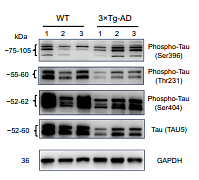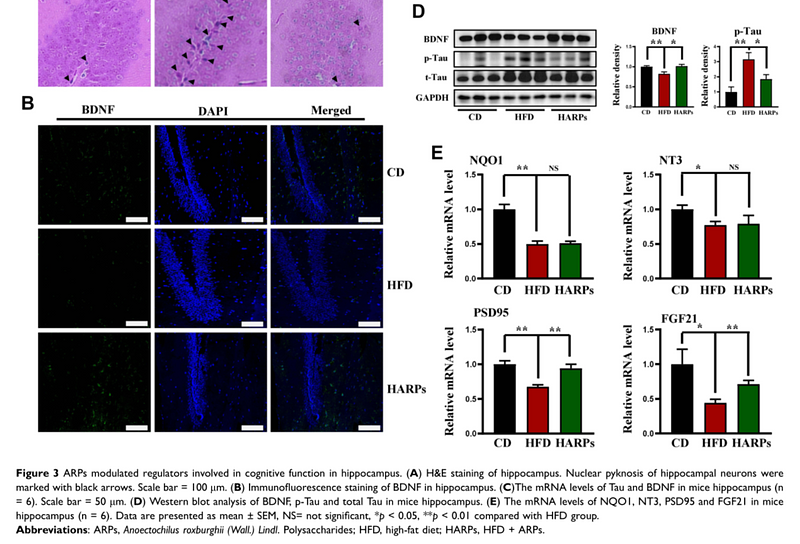Phospho-Tau (T231) Recombinant Rabbit Monoclonal Antibody [SC58-08]

Specification
Catalog# ET1610-31
Phospho-Tau (T231) Recombinant Rabbit Monoclonal Antibody [SC58-08]
-
WB
-
IHC-P
-
IP
-
IF-Tissue
-
IHC-Fr
-
Human
-
Mouse
-
Rat
-
Cynomolgus monkey
-
Pig
Overview
Product Name
Phospho-Tau (T231) Recombinant Rabbit Monoclonal Antibody [SC58-08]
Antibody Type
Recombinant Rabbit monoclonal Antibody
Immunogen
Synthetic phospho-peptide corresponding to residues surrounding Thr231 of human Tau-F (P10636-8).
Species Reactivity
Human, Mouse, Rat (Predicted: Cynomolgus monkey, Pig)
Validated Applications
WB, IHC-P, IP, IF-Tissue, IHC-Fr
Molecular Weight
Predicted band size: 46 kDa
Positive Control
Human brain tissue lysate, mouse brain tissue lysate, rat brain tissue lysate, mouse brain tissue, rat brain tissue, human brain tissue, mouse hippocampus tissue.
Conjugation
unconjugated
Clone Number
SC58-08
RRID
Product Features
Form
Liquid
Storage Instructions
Shipped at 4℃. Store at +4℃ short term (1-2 weeks). It is recommended to aliquot into single-use upon delivery. Store at -20℃ long term.
Storage Buffer
1*TBS (pH7.4), 0.05% BSA, 40% Glycerol. Preservative: 0.05% Sodium Azide.
Isotype
IgG
Purification Method
Protein A affinity purified.
Application Dilution
-
WB
-
1:2,000
-
IHC-P
-
1:1,000
-
IF-Tissue
-
1:200
-
IHC-Fr
-
1:200-1:500
Applications in Publications
Species in Publications
| Mouse | See 2 publications below |
| Human | See 1 publications below |
| Pig | See 1 publications below |
Target
Function
Tau, also known as MAPT (microtubule-associated protein tau), MAPTL, MTBT1 or TAU, is a 758 amino acid protein that localizes to the cytoplasm, as well as to the cytoskeleton and the cell membrane, and contains four Tau/MAP repeats. Expressed in neuronal tissue and existing as multiple alternatively spliced isoforms, Tau functions to promote microtubule assembly and stability and is thought to be involved in the maintenance of neuronal polarity. Tau may also link microtubules with neural plasma membrane components and, addition to its role in microtubule stability, is also necessary for cytoskeletal plasticity. Tau is highly subject to a variety of post-translational modifications, including phosphorylation on serine and threonine residues, polyubiquitination (and subsequent proteasomal degradation) and glycation of specific Tau isoforms. Defects in the gene encoding Tau are associated with Alzheimers disease, pallido-ponto-nigral degeneration (PPND), corticobasal degeneration (CBD) and progressive supranuclear palsy (PSP).
Background References
1. Wang, HY. et al. 2012. Reducing amyloid-related Alzheimer\'s disease pathogenesis by a small molecule targeting filamin A. J. Neurosci. 32: 9773-9784.
2. Kamnaksh, A. et al. 2012. Neurobehavioral, cellular, and molecular consequences of single and multiple mild blast exposure. Electrophoresis. 33: 3680-3692.
Tissue Specificity
Expressed in neurons. Isoform PNS-tau is expressed in the peripheral nervous system while the others are expressed in the central nervous system.
Post-translational Modification
Phosphorylation at serine and threonine residues in S-P or T-P motifs by proline-directed protein kinases (PDPK1, CDK1, CDK5, GSK3, MAPK) (only 2-3 sites per protein in interphase, seven-fold increase in mitosis, and in the form associated with paired helical filaments (PHF-tau)), and at serine residues in K-X-G-S motifs by MAP/microtubule affinity-regulating kinase (MARK1, MARK2, MARK3 or MARK4), causing detachment from microtubules, and their disassembly. Phosphorylation decreases with age. Phosphorylation within tau/MAP's repeat domain or in flanking regions seems to reduce tau/MAP's interaction with, respectively, microtubules or plasma membrane components. Phosphorylation on Ser-610, Ser-622, Ser-641 and Ser-673 in several isoforms during mitosis. Phosphorylation at Ser-548 by GSK3B reduces ability to bind and stabilize microtubules. Phosphorylation at Ser-579 by BRSK1 and BRSK2 in neurons affects ability to bind microtubules and plays a role in neuron polarization. Phosphorylated at Ser-554, Ser-579, Ser-602, Ser-606 and Ser-669 by PHK. Phosphorylation at Ser-214 by SGK1 mediates microtubule depolymerization and neurite formation in hippocampal neurons. There is a reciprocal down-regulation of phosphorylation and O-GlcNAcylation. Phosphorylation on Ser-717 completely abolishes the O-GlcNAcylation on this site, while phosphorylation on Ser-713 and Ser-721 reduces glycosylation by a factor of 2 and 4 respectively. Phosphorylation on Ser-721 is reduced by about 41.5% by GlcNAcylation on Ser-717. Dephosphorylated at several serine and threonine residues by the serine/threonine phosphatase PPP5C.; Polyubiquitinated. Requires functional TRAF6 and may provoke SQSTM1-dependent degradation by the proteasome (By similarity). PHF-tau can be modified by three different forms of polyubiquitination. 'Lys-48'-linked polyubiquitination is the major form, 'Lys-6'-linked and 'Lys-11'-linked polyubiquitination also occur.; O-glycosylated. O-GlcNAcylation content is around 8.2%. There is reciprocal down-regulation of phosphorylation and O-GlcNAcylation. Phosphorylation on Ser-717 completely abolishes the O-GlcNAcylation on this site, while phosphorylation on Ser-713 and Ser-721 reduces O-GlcNAcylation by a factor of 2 and 4 respectively. O-GlcNAcylation on Ser-717 decreases the phosphorylation on Ser-721 by about 41.5%.; Glycation of PHF-tau, but not normal brain TAU/MAPT. Glycation is a non-enzymatic post-translational modification that involves a covalent linkage between a sugar and an amino group of a protein molecule forming ketoamine. Subsequent oxidation, fragmentation and/or cross-linking of ketoamine leads to the production of advanced glycation endproducts (AGES). Glycation may play a role in stabilizing PHF aggregation leading to tangle formation in AD.
Subcellular Location
Secreted, cytoskeleton, cell membrane, cytosol, axon, dendrite.
Synonyms
AI413597 antibody
AW045860 antibody
DDPAC antibody
FLJ31424 antibody
FTDP 17 antibody
G protein beta1/gamma2 subunit interacting factor 1 antibody
MAPT antibody
MAPTL antibody
MGC134287 antibody
MGC138549 antibody
ExpandAI413597 antibody
AW045860 antibody
DDPAC antibody
FLJ31424 antibody
FTDP 17 antibody
G protein beta1/gamma2 subunit interacting factor 1 antibody
MAPT antibody
MAPTL antibody
MGC134287 antibody
MGC138549 antibody
MGC156663 antibody
Microtubule associated protein tau antibody
Microtubule associated protein tau isoform 4 antibody
Microtubule-associated protein tau antibody
MSTD antibody
Mtapt antibody
MTBT1 antibody
MTBT2 antibody
Neurofibrillary tangle protein antibody
Paired helical filament tau antibody
Paired helical filament-tau antibody
PHF tau antibody
PHF-tau antibody
PPND antibody
PPP1R103 antibody
Protein phosphatase 1, regulatory subunit 103 antibody
pTau antibody
RNPTAU antibody
TAU antibody
TAU_HUMAN antibody
Tauopathy and respiratory failure, included antibody
CollapseImages
-

☑ Cell treatment (CT)
Western blot analysis of Phospho-Tau (T231) on different lysates with Rabbit anti-Phospho-Tau (T231) antibody (ET1610-31) at 1/2,000 dilution.
Lane 1: Human brain tissue lysate
Lane 2: Mouse brain tissue lysate
Lane 3: Rat brain tissue lysate
Lane 4: Mouse brain treated with λpp for 1 hour tissue lysate
Lysates/proteins at 20 µg/Lane.
Predicted band size: 46 kDa
Observed band size: 35-70 kDa
Exposure time: 3 minutes;
4-20% SDS-PAGE gel.
Proteins were transferred to a PVDF membrane and blocked with 5% NFDM/TBST for 1 hour at room temperature. The primary antibody (ET1610-31) at 1/2,000 dilution was used in 5% NFDM/TBST at 4℃ overnight. Goat Anti-Rabbit IgG - HRP Secondary Antibody (HA1001) at 1/50,000 dilution was used for 1 hour at room temperature. -

Immunohistochemical analysis of paraffin-embedded mouse brain tissue with Rabbit anti-Phospho-Tau (T231) antibody (ET1610-31) at 1/1,000 dilution.
The section was pre-treated using heat mediated antigen retrieval with Tris-EDTA buffer (pH 9.0) for 20 minutes. The tissues were blocked in 1% BSA for 20 minutes at room temperature, washed with ddH2O and PBS, and then probed with the primary antibody (ET1610-31) at 1/1,000 dilution for 1 hour at room temperature. The detection was performed using an HRP conjugated compact polymer system. DAB was used as the chromogen. Tissues were counterstained with hematoxylin and mounted with DPX. -

Immunohistochemical analysis of paraffin-embedded rat brain tissue with Rabbit anti-Phospho-Tau (T231) antibody (ET1610-31) at 1/1,000 dilution.
The section was pre-treated using heat mediated antigen retrieval with Tris-EDTA buffer (pH 9.0) for 20 minutes. The tissues were blocked in 1% BSA for 20 minutes at room temperature, washed with ddH2O and PBS, and then probed with the primary antibody (ET1610-31) at 1/1,000 dilution for 1 hour at room temperature. The detection was performed using an HRP conjugated compact polymer system. DAB was used as the chromogen. Tissues were counterstained with hematoxylin and mounted with DPX. -

Immunohistochemical analysis of paraffin-embedded human brain tissue with Rabbit anti-Phospho-Tau (T231) antibody (ET1610-31) at 1/1,000 dilution.
The section was pre-treated using heat mediated antigen retrieval with Tris-EDTA buffer (pH 9.0) for 20 minutes. The tissues were blocked in 1% BSA for 20 minutes at room temperature, washed with ddH2O and PBS, and then probed with the primary antibody (ET1610-31) at 1/1,000 dilution for 1 hour at room temperature. The detection was performed using an HRP conjugated compact polymer system. DAB was used as the chromogen. Tissues were counterstained with hematoxylin and mounted with DPX. -

Application: IF-tissue
Species: Mouse
Site: Cerebral cortex
Sample: Paraffin-embedded section
Antibody concentration: 1/200 -

Application: IF-tissue
Species: Mouse
Site: Hippocampus
Sample: Paraffin-embedded section
Antibody concentration: 1/200 -

Application: IF-tissue
Species: Rat
Site: Cerebral cortex
Sample: Paraffin-embedded section
Antibody concentration: 1/200 -

Application: IHC-Fr
Species: Mouse
Site: Hippocampus
Sample: Frozen section
Antibody concentration: 1/200
Antigen retrieval: Not required -

Application: IHC-Fr
Species: Mouse
Site: Cerebral cortex
Sample: Frozen section
Antibody concentration: 1/200
Antigen retrieval: Not required
Please note: All products are "FOR RESEARCH USE ONLY AND ARE NOT INTENDED FOR DIAGNOSTIC OR THERAPEUTIC USE"
Citation
-
Highly efficient prime editors for mammalian genome editing based on porcine retrovirus reverse transcriptase
Author: Weiwei Liu, Wenxin Duan, Zhiwei Peng, Yaya Liao, Xiaoguo Wang, Ruirong Liu, Qiqi Jing, Haoyun Jiang, Yuhang Fan, Liming Ge, Lusheng Huang, Yuyun Xing
PMID: 40885667

Journal: Trends in Biotechnology
Application: WB
Reactivity: Pig
Publish date: 2025 Aug
-
Citation
-
Discovery of ZJCK-6-46: A Potent, Selective, and Orally Available Dual-Specificity Tyrosine Phosphorylation-Regulated Kinase 1A Inhibitor for the Treatment of Alzheimer's Disease
Author: Chen Huanhua,et al
PMID: 39041662

Journal: Journal Of Medicinal Chemistry
Application: WB,IHC-P
Reactivity: Mouse,Human
Publish date: 2024 Jul
-
Citation
-
Dietary Supplement of Anoectochilus roxburghii (Wall.) Lindl. Polysaccharides Ameliorates Cognitive Dysfunction Induced by High Fat Diet via “Gut-Brain” Axis
Author:
PMID: 35762015

Journal: Drug Design Development And Therapy
Application: WB
Reactivity: Mouse
Publish date: 2022 Jun
-
Citation
Products with the same target and pathway
Tau Rabbit Polyclonal Antibody
Application: WB,IF-Cell,IHC-P
Reactivity: Human,Mouse,Rat
Conjugate: unconjugated
Phospho-Tau (T231) Recombinant Rabbit Monoclonal Antibody [PSH01-05]
Application: WB,IHC-P
Reactivity: Human,Mouse,Rat
Conjugate: unconjugated
Phospho-Tau (S214) Recombinant Rabbit Monoclonal Antibody [JE66-83]
Application: WB
Reactivity: Human,Mouse,Rat
Conjugate: unconjugated
Phospho-Tau (S198) Recombinant Rabbit Monoclonal Antibody [JE66-79]
Application: WB
Reactivity: Human,Mouse,Rat
Conjugate: unconjugated
Phospho-Tau (T217) Recombinant Rabbit Monoclonal Antibody [PSH09-33]
Application: WB,IF-Cell,IHC-P,IHC-Fr
Reactivity: Human,Mouse,Rat
Conjugate: unconjugated
Phospho-Tau (S404) Recombinant Rabbit Monoclonal Antibody [JE47-88]
Application: WB,IHC-P
Reactivity: Human,Mouse,Rat
Conjugate: unconjugated
Phospho-Tau (S199) Recombinant Rabbit Monoclonal Antibody [JE46-95]
Application: WB
Reactivity: Human,Mouse,Rat
Conjugate: unconjugated
Phospho-Tau (T231) Recombinant Rabbit Monoclonal Antibody [PSH01-04]
Application: WB,IHC-P,IF-Tissue
Reactivity: Human,Mouse,Rat
Conjugate: unconjugated
Phospho-Tau (S199) Recombinant Rabbit Monoclonal Antibody [JE66-80]
Application: WB
Reactivity: Human,Mouse,Rat
Conjugate: unconjugated
Phospho-Tau (S396) Recombinant Rabbit Monoclonal Antibody [SN62-09]
Application: WB,IF-Cell,IF-Tissue,IHC-P,IHC-Fr
Reactivity: Mouse,Rat,Human,Cynomolgus monkey,Pig
Conjugate: unconjugated
Phospho-Tau (S404) Recombinant Rabbit Monoclonal Antibody [JE66-82]
Application: WB,IHC
Reactivity: Human,Mouse,Rat
Conjugate: unconjugated
Phospho-Tau (T181) Recombinant Rabbit Monoclonal Antibody [PSH05-42]
Application: WB,IHC-P
Reactivity: Human,Mouse,Cynomolgus monkey
Conjugate: unconjugated
Tau Recombinant Rabbit Monoclonal Antibody [SZ03-03]
Application: WB,IHC-P,IP,IHC-Fr
Reactivity: Human,Mouse,Rat
Conjugate: unconjugated
Phospho-Tau (S356) Recombinant Rabbit Monoclonal Antibody [JE46-86]
Application: WB
Reactivity: Human,Mouse,Rat
Conjugate: unconjugated
Tau Recombinant Rabbit Monoclonal Antibody [SD205-09]
Application: WB,IF-Cell,IF-Tissue,IHC-P,FC,IHC-Fr
Reactivity: Human,Mouse,Rat,Cynomolgus monkey,Pig
Conjugate: unconjugated
Phospho-Tau (S202) Recombinant Rabbit Monoclonal Antibody [JE66-81]
Application: WB
Reactivity: Human,Mouse,Rat
Conjugate: unconjugated
Phospho-Tau (S324) Recombinant Rabbit Monoclonal Antibody [JE30-73]
Application: WB
Reactivity: Human,Mouse,Rat
Conjugate: unconjugated


















